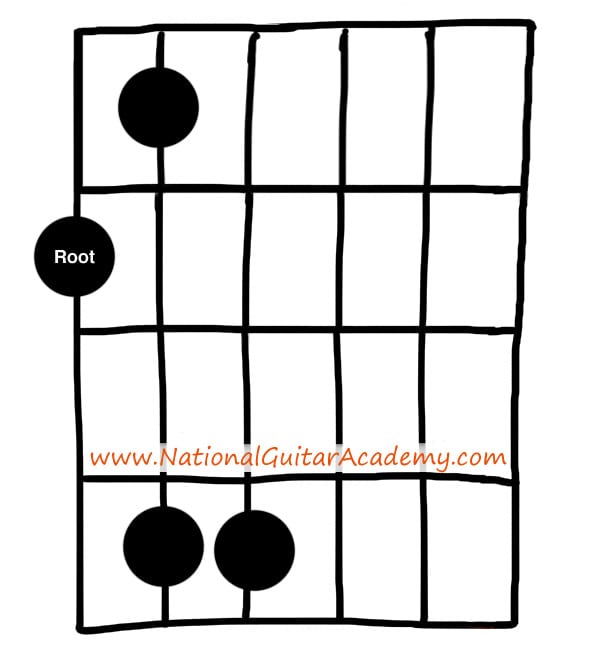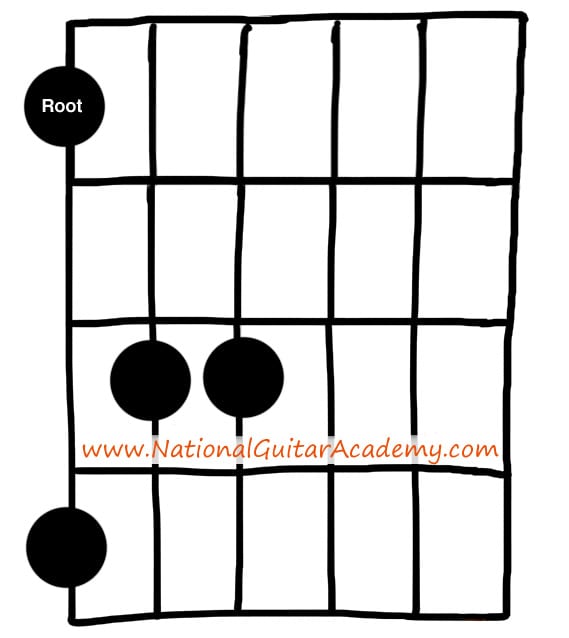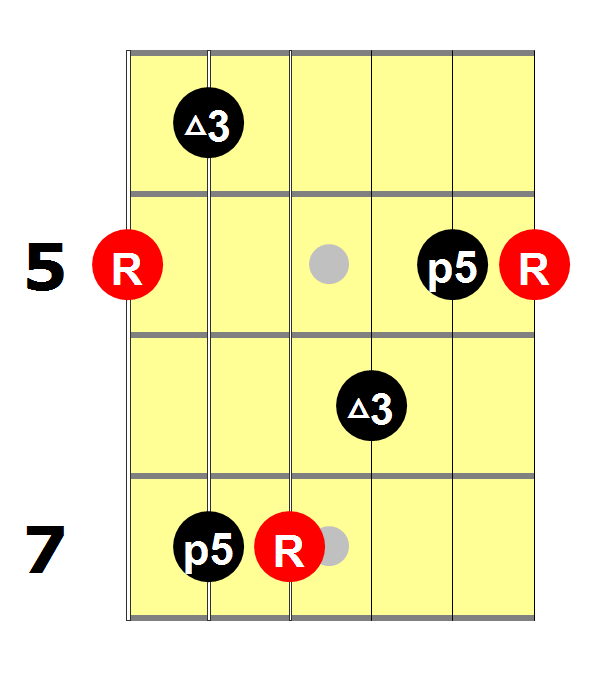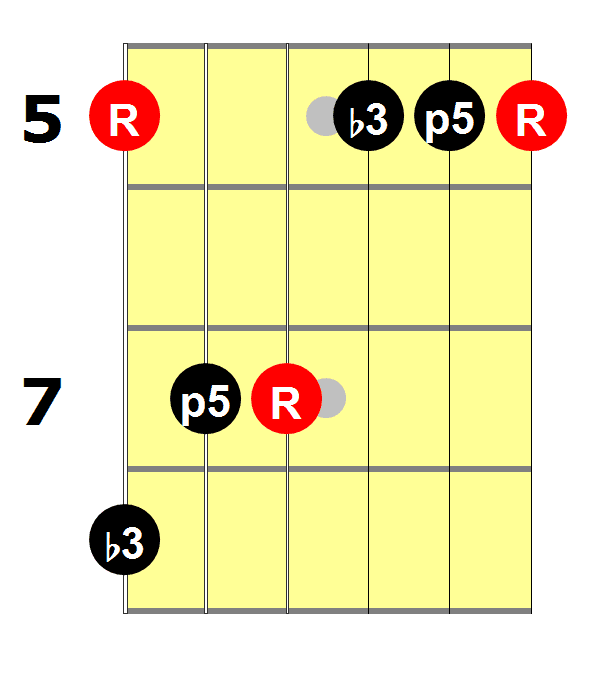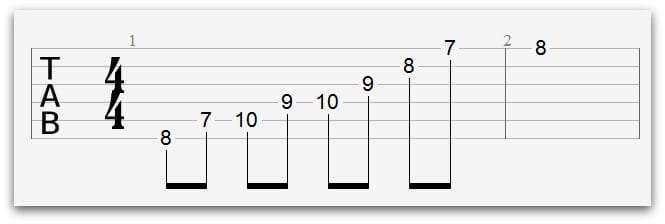Intermediate Guitar Arpeggios
Once you’ve learned how to play open arpeggios. You must learn how to play fretted arpeggios.
The two main arpeggio types are:
- The Major Arpeggio.
- The Minor Arpeggio.
We’re going to learn both one octave and two octaves for BOTH of these arpeggios. For each of these examples, we’re going to use the key of A.
The Major Arpeggio (1 Octave)
Here’s a 1 octave major arpeggio, to play this in the key of A. Start it on the 5th fret.
The Minor Arpeggio (1 Octave)
Here’s 1 octave minor arpeggio. To play this in the key of A. Start it on the 5th fret.
Quick Tip!
Both of these arpeggios can be moved up and down the E string (6th string.) and onto the A string. (5th string.)
Try this:
- Move the major and minor arpeggios up to the 7th fret on the E string. (6th string.)
When you do this your major arpeggio becomes a:
- B major arpeggio.
Your minor arpeggio becomes a:
- B minor arpeggio.
Once you’ve mastered this:
- Move the major and minor arpeggio shapes onto the 5th fret of the A string. (5th string.)
When you do this, you can use the EXACT same shape, however you have now changed the key of the arpeggio.
These arpeggios now become:
- D Major Arpeggio.
- D Minor Arpeggio.
You can move BOTH of these shapes to any fret on the E (6th string) or A string. (5th string.)
Why does this work?
This works because arpeggios are ‘moveable shapes’.
This means that you can use the EXACT same arpeggio shape ALL over the fret board. All you have to do is change the root note.
The root note is the first note in an arpeggio, and tells you the arpeggios key. When you change this, you are changing the key of the arpeggio.
To change the key of an arpeggio, you must know what the root notes are on the E string (6th string) and A string. (5th string.)
Here are the root notes on the E string. (6th string.)
To change the key of an arpeggio, change the starting note.
For example, to play a major arpeggio in the key of G. Start on the 3rd fret.
You can apply the same concept to arpeggios on the A string, however the notes are different. Here are the root notes on the A string. (5th string.)
Bonus Tip!
You can also move ALL of these arpeggio shapes up 12th frets. For example, if you want to play a G major arpeggio. You can play it on either the 3rd fret or the 15th fret.
Major And Minor Arpeggios (2 Octaves)
Here are the 2 octave shapes for the major and minor arpeggios.
Major Arpeggio (2 Octaves)
Minor Arpeggios (2 Octaves)
Once you’ve mastered these shapes, try and play them in ALL keys.
Why should I learn arpeggios?
Arpeggios are essential for any guitarist to know, here’s why:
- They enhance your musicality and vocabulary.
If you want to become an epic lead guitarist, you must know how to play arpeggios.
Want to hear some of the best guitar solos of all time? Check out this article by Guitar World: 50 Greatest Guitar Solos
- Learning arpeggios enhances your guitar technique.
Learning arpeggios is a great way of enhancing your dexterity and technique. If you want to move around the fret board at lightening speed, learn to play guitar arpeggios.
When can I use guitar arpeggios?
There are two musical situations when you can use guitar arpeggios. These are:
- Over a musical key.
- Over a specific chord.
Using Arpeggios Over A Musical Key
If you want to use arpeggios over a musical key, you must know what key the song is in. This tells you what arpeggio you can use.
For example, if something is in the key of C major. You can use a:
- C Major Arpeggio.
Or if something is in the key of A minor:
You can use a:
- A Minor Arpeggio.
Pro Arpeggio Tip!
If you want to get fancy, you can explore other arpeggios. Here’s a cool guitar hack which will give you some extra arpeggio options.
For every major arpeggio, you can play a minor equivalent 3 frets down.
For example, if you were playing a C major arpeggio on the 8th fret. You can also play an A minor arpeggio, 3 frets down.
This means that if something is in the key of C major, you can either play a:
- C Major Arpeggio.
Or a:
- A Minor Arpeggio.
Or if something is in the key of A minor, you can use either a:
- A Minor Arpeggio.
Or a:
- C Major Arpeggio.
This is known as ‘relative major and minor keys’. To learn about this concept, go here: How To Play Lead Guitar
It's hard to understand which scales work with which keys.
So we created a cheat-sheet! A key and scale-finder that you can use again and again.
Get a custom guitar-learning plan here: Click here for GuitarMetrics™ Learn from the world's best guitar educators: Click here for our guitar coursesDownload our lead guitar cheat-sheet to make things easier

Get your personalised guitar-learning plan 🎸
World-Class Guitar Courses 🌎
Using Guitar Arpeggios Over Chords
A more advanced way of using arpeggios over each chord.
For example, if your chord progression was:
E Major | C# Minor | B Major | A Major
You could use the following arpeggios:
- E major arpeggio.
- C# minor arpeggio.
- B major arpeggio.
- A major arpeggio.
This is a cool technique as you were outlining EVERY single chord in the progression.
Alternatively, if you wanted to make things easier, you could just use a:
- E major arpeggio.
This works, as all of the chords in the key of E. To learn more about the chords in the key of E, go here: Chords In The Key Of E
Advanced Guitar Arpeggios
Once you’ve mastered your basic major and minor arpeggios, the next step is to learn:
- Major 7th arpeggios.
- Minor 7th arpeggios.
- Dominant 7th arpeggios.
We’re going to show you each of these examples in the key of C.
C Major 7 Arpeggio
Here’s the tab for a C major 7 arpeggio:
You can this over:
- Anything in the key of C major/A Minor.
Or a:
- A C Major 7 chord.
C Minor 7 Arpeggio
Here’s a C minor 7 arpeggio:
You can use this over:
- Anything in the key of C minor/Eb major.
- A C minor 7 chord.
- A C minor blues.
C7 Arpeggio
Here’s a C7 arpeggio:
You can use this over a:
- C7 chord.
- Anything in the key of C major/A minor.
- A C blues.
This arpeggio has a cool bluesy sound. To learn more about the blues, go here: Blues Guitar Lessons For Beginners – 4 Ways To Sound Awesome Quickly
Once you feel comfortable with these arpeggios, try playing each of these arpeggios in every key. You can do this by moving each arpeggio shape up and down the fret board.
If you want to learn more advanced guitar arpeggios, go here:Jazz Guitar: A 5-Step Programme For Rapid Jazz Skill
Take our 60-second quiz & get your results: Take The Quiz Click here to learn more about National Guitar Academy membership Look cooler! Check out our merch: Click here to see our merch store Join over 250,000 other guitar learners and subscribe to our guitar-tips-by-email service. (It's free.) We'll send you a series of lessons that will move you to the next level of your guitar journey. Learn how everything fits together quickly, easily and effectively. We share ninja tips (for instant fun!) but also timeless fundamentals that will deepen your understanding.What Type of Guitarist Are You?
Join the world's best online guitar school 🌎

Cool Guitar T-shirts 😎
Want free guitar tips and video lessons delivered to your inbox?

How To Learn Guitar: An 11-Step Programme For Beginners How To Choose The Perfect Beginner Guitar Learn about National Guitar Academy: About Us Visit our YouTube channel for fun guitar videos. Join us on Facebook for daily guitar tips. Listen to our Learn Guitar Podcast for rapid guitar progress. Check out our free chord lessons.Popular Lessons
More Cool Guitar Stuff
Where should we send it?
Get our best guitar tips & videos

